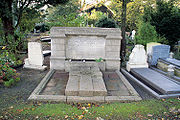
Eduard Cuypers
Encyclopedia
Eduard Cuypers was a Dutch
architect
.
Cuypers was trained in the architectural practice of his uncle P.J.H. Cuypers
and in 1881 set up his own office in Amsterdam. His good contacts with businessmen earned him commissions for offices, shops and houses. In spite of his training by his uncle, the country's major architect of neo-Gothic, his work was closely related to Neo-renaissance
and Jugendstil. Although he designed several churches, unlike his uncle and his cousin Joseph Cuypers, Eduard did not confine himself solely to ecclesiastical architecture. Instead, he designed a few dozen railwaystations, which were mostly built in the north of the country, several hospitals and many houses.
 Cuypers and his employees also designed pieces of furniture and other objects for interiors, such as lamps. In 1905 Cuypers published Het Huis, Oud & Nieuw (The House, Old and New), a magazine for interior design that was published until he died in 1927.
Cuypers and his employees also designed pieces of furniture and other objects for interiors, such as lamps. In 1905 Cuypers published Het Huis, Oud & Nieuw (The House, Old and New), a magazine for interior design that was published until he died in 1927.
The office of Eduard Cuypers is considered as the origin of the Amsterdam School
because the leaders of this style, Michel de Klerk
, Johan van der Mey
and Piet Kramer
, were all trained there. Berend Tobia Boeyinga
, one of the most important followers of the Amsterdam school, also worked for Cuypers for a while. After Cuypers died in 1927, his office was continued by others. The current name is A/D Amstel Architects.
Netherlands
The Netherlands is a constituent country of the Kingdom of the Netherlands, located mainly in North-West Europe and with several islands in the Caribbean. Mainland Netherlands borders the North Sea to the north and west, Belgium to the south, and Germany to the east, and shares maritime borders...
architect
Architect
An architect is a person trained in the planning, design and oversight of the construction of buildings. To practice architecture means to offer or render services in connection with the design and construction of a building, or group of buildings and the space within the site surrounding the...
.
Cuypers was trained in the architectural practice of his uncle P.J.H. Cuypers
Pierre Cuypers
Petrus Josephus Hubertus Cuypers was a Dutch architect. His name is most frequently associated with the Amsterdam Central Station and the Rijksmuseum , both in Amsterdam. More representative for his oeuvre, however, are numerous churches, of which he designed more than 100...
and in 1881 set up his own office in Amsterdam. His good contacts with businessmen earned him commissions for offices, shops and houses. In spite of his training by his uncle, the country's major architect of neo-Gothic, his work was closely related to Neo-renaissance
Neo-Renaissance
Renaissance Revival is an all-encompassing designation that covers many 19th century architectural revival styles which were neither Grecian nor Gothic but which instead drew inspiration from a wide range of classicizing Italian modes...
and Jugendstil. Although he designed several churches, unlike his uncle and his cousin Joseph Cuypers, Eduard did not confine himself solely to ecclesiastical architecture. Instead, he designed a few dozen railwaystations, which were mostly built in the north of the country, several hospitals and many houses.

The office of Eduard Cuypers is considered as the origin of the Amsterdam School
Amsterdam School
The Amsterdam School is a style of architecture that arose from 1910 through about 1930 in The Netherlands...
because the leaders of this style, Michel de Klerk
Michel de Klerk
Michel de Klerk was a Dutch architect.He was one of the founding architects of the movement Amsterdam School. Early in his career he worked for other architects, including Eduard Cuypers. Of his many outstanding designs, very few have actually been built...
, Johan van der Mey
Johan van der Mey
Johan Melchior van der Mey was a Dutch architect best known for the landmark Scheepvaarthuis building in Amsterdam located at Prins Hendrikkade, 1012....
and Piet Kramer
Piet Kramer
Pieter Lodewijk Kramer was a Dutch architect, one of the most important architects of the Amsterdam School ....
, were all trained there. Berend Tobia Boeyinga
Berend Tobia Boeyinga
Berend Tobia Boeyinga was a Dutch architect noted for his Calvinist church buildings and as a practicing member of the Amsterdam School....
, one of the most important followers of the Amsterdam school, also worked for Cuypers for a while. After Cuypers died in 1927, his office was continued by others. The current name is A/D Amstel Architects.

